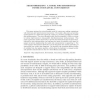Free Online Productivity Tools
i2Speak
i2Symbol
i2OCR
iTex2Img
iWeb2Print
iWeb2Shot
i2Type
iPdf2Split
iPdf2Merge
i2Bopomofo
i2Arabic
i2Style
i2Image
i2PDF
iLatex2Rtf
Sci2ools
92
Voted
PPL
2006
2006
Microthreading a Model for Distributed Instruction-level Concurrency
This paper analyses the micro-threaded model of concurrency making comparisons with both data and instruction-level concurrency. The model is fine grain and provides synchronisation in a distributed register file, making it a promising candidate for scalable chip-multiprocessors. The micro-threaded model was first proposed in 1996 as a means to tolerate high latencies in data-parallel, distributed-memory multi-processors. This paper explores the model's opportunity to provide the simultaneous issue of instructions, required for chip multiprocessors, and discusses the issues of scalability with regard to support structures implementing the model and communication in supporting it. The model supports deterministic distribution of code fragments and dynamic scheduling of instructions from within those fragments. The hardware also recognises different classes of variables from the register specifiers, which allows the hardware to manage locality and optimise communication so that it ...
| Added | 14 Dec 2010 |
| Updated | 14 Dec 2010 |
| Type | Journal |
| Year | 2006 |
| Where | PPL |
| Authors | Chris R. Jesshope |
Comments (0)

